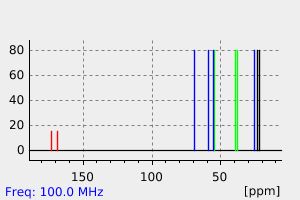3-异丁基-8-羟基六氢吡咯并[1,2-A]吡嗪-1,4-二酮 | 115006-86-5
-
物化性质
-
计算性质
-
ADMET
-
安全信息
-
SDS
-
制备方法与用途
-
上下游信息
-
文献信息
-
表征谱图
-
同类化合物
-
相关功能分类
-
相关结构分类
物化性质
-
沸点:486.9±45.0 °C(Predicted)
-
密度:1.24±0.1 g/cm3(Predicted)
计算性质
-
辛醇/水分配系数(LogP):0.1
-
重原子数:16
-
可旋转键数:2
-
环数:2.0
-
sp3杂化的碳原子比例:0.82
-
拓扑面积:69.6
-
氢给体数:2
-
氢受体数:3
安全信息
-
包装等级:III
-
危险类别:9
-
危险性防范说明:P273,P301+P312+P330,P305+P351+P338,P314
-
危险品运输编号:3077
-
危险性描述:H302,H319,H372,H410
反应信息
-
作为反应物:描述:3-异丁基-8-羟基六氢吡咯并[1,2-A]吡嗪-1,4-二酮 在 碘 、 三乙胺 作用下, 以 1,2-二氯乙烷 为溶剂, 反应 0.83h, 生成 (3S,6S)-1-acetoxymethyl-6-(2-[4R-hydroxy-2S-methoxycarbonylpyrrolidinyl] ethyl)-3-isobutyl piperazine-2,5-dione参考文献:名称:通过定制化单元的选择性修饰合成具有定制N和α链的二酮哌嗪支架摘要:在DKP基板中对Hyp可定制单元的选择性操作允许生成具有四个空间定向的量身定制链的刚性支架。关键步骤是多米诺骨牌断裂-氧化过程,该过程允许生成N取代的DKP。本文描述了这种方法的通用性,其以高光学纯度生产用于材料和药物发现的支架。DOI:10.1002/adsc.202000470
-
作为产物:描述:反式-4-羟基-L-脯氨酸甲酯盐酸盐 在 盐酸-N-乙基-Nˊ-(3-二甲氨基丙基)碳二亚胺 、 三乙胺 、 三氟乙酸 作用下, 以 二氯甲烷 为溶剂, 反应 35.0h, 生成 3-异丁基-8-羟基六氢吡咯并[1,2-A]吡嗪-1,4-二酮参考文献:名称:Enantiomerically pure piperazines via NaBH4/I2 reduction of cyclic amides摘要:Enantiomerically pure (3S,7R,8aS)-3-phenyloctahydropyrrolo[1,2-a]pyrazine-7-ol, (3S,7R,8aS)-3-methyl octahydropyrrolo[1,2-a]pyrazine-7-ol, (3S,7R,8aS)-3-isopropyloctahydropyrrolo[1,2-a]pyrazine-7-ol and (35,7R,8aS)-3-isobutyloctahydropyrrolo[1,2-a]pyrazine-7-ol 16d were synthesized via preparation of the corresponding cyclic amides from enantiomerically pure L-proline and hydroxyproline derivatives followed by reduction using sodium borohydride-iodine. (C) 2016 Elsevier Ltd. All rights reserved.DOI:10.1016/j.tetasy.2016.12.002
文献信息
-
Limosilactobacillus (Lactobacillus) fermentum ALAL020, a Probiotic Candidate Bacterium, Produces a Cyclic Dipeptide That Suppresses the Periodontal Pathogens Porphyromonas gingivalis and Prevotella intermedia作者:Tomomi Kawai、Tomoko Ohshima、Takeshi Tanaka、Satoshi Ikawa、Atsushi Tani、Naoya Inazumi、Ryoichi Shin、Yukie Itoh、Karen Meyer、Nobuko MaedaDOI:10.3389/fcimb.2022.804334日期:——
Periodontal disease develops as a result of oral microbiota in dysbiosis, followed by the growth of periodontal pathogens such as
Porphyromonas gingivalis andPrevotella intermedia . In case of acute symptoms, antibacterial agents and disinfectants are administered, however the appearance of drug-resistant bacteria and allergies cause problems. In recent years, studies on the effects of probiotics have been conducted as an alternative therapy for periodontitis. However, the basic mechanism of the inhibitory effect of probiotic bacteria on periodontal disease has not been clearly elucidated. To clarify the antibacterial mechanism of probiotics against periodontal pathogens, we usedLimosilactobacillus (Lactobacillus) fermentum ALAL020, which showed the strongest antibacterial activity againstP. gingivalis andP. intermedia among 50 screened lactic acid bacteria strains. The antibacterial substances produced were identified and structurally analyzed. After neutralizing the MRS liquid culture supernatant of ALAL020 strain, the molecular weight (m/z) of the main antibacterial substance separated by gel filtration column chromatography and reverse phase HPLC was 226.131. This low molecular weight compound was analyzed by LC-MS and disclosed the composition formula C11H18O3N2, however the molecular structure remained unknown. Then, structural analysis by NMR revealed C11H18O3N2 as the cyclic dipeptide, “hexahydro-7-hydroxy-3- (2-methylpropyl) pyrrolo [1,2-a] pyrazine-1,4-dion cyclo (Hyp-Leu) “. Based on the results of this analysis, cyclo (Hyp-Leu) was chemically synthesized and the antibacterial activity againstP. gingivalis andP. intermedia was measured. The minimum inhibitory concentration (MIC) was 2.5 g/L and the minimum bactericidal concentration (MBC) was shown to be less than 5 g/L. In addition, anin vitro epithelial tissue irritation test at 10 g/L showed no tissue toxicity. So far there are no reports of this peptide being produced by probiotic bacteria. Furthermore, antibacterial activity of this cyclic dipeptide against periodontal disease bacteria has not been confirmed. The results of this study might lead to a comprehensive understanding of the antibacterial mechanism against periodontal disease bacteria in future, and are considered applicable for the prevention of periodontal disease.牙周疾病是由口腔微生物群落失调引起的,随后是牙周病原菌(如牙龈卟啉菌和中间丛菌)的增长。在急性症状的情况下,会使用抗菌剂和消毒剂,但耐药菌和过敏引起问题。近年来,对益生菌治疗牙周炎的影响进行了研究作为替代疗法。然而,益生菌对牙周疾病的抑制作用的基本机制尚未得到明确阐明。为了阐明益生菌对牙周病原菌的抗菌机制,我们使用了50个筛选的乳酸菌菌株中对牙龈卟啉菌和中间丛菌的抗菌活性最强的LimosiLActobacillus (LActobacillus) fermentum ALAL020。已经确定并结构分析了产生的抗菌物质。在中和ALAL020菌株的MRS液体培养上清液后,通过凝胶过滤柱层析和反相高效液相色谱法分离的主要抗菌物质的分子量(m/z)为226.131。这种低分子量化合物通过LC-MS分析,揭示了C11H18O3N2的组成式,但分子结构仍未知。然后,通过NMR的结构分析,发现C11H18O3N2是环状二肽“六氢-7-羟基-3-(2-甲基丙基)吡咯[1,2-a]吡嗪-1,4-二酮环(Hyp-Leu)”。根据这种分析的结果,合成了环(Hyp-Leu),并测量了其对牙龈卟啉菌和中间丛菌的抗菌活性。最小抑菌浓度(MIC)为2.5 g / L,最小杀菌浓度(MBC)小于5 g / L。此外,10 g / L的体外上皮组织刺激试验未显示组织毒性。迄今为止,没有报道益生菌产生这种肽。此外,这种环状二肽对牙周疾病细菌的抗菌活性尚未得到确认。本研究的结果可能导致未来对牙周疾病细菌的抗菌机制的全面了解,并被认为适用于预防牙周疾病。 -
Identification of Collagen-Derived Hydroxyproline (Hyp)-Containing Cyclic Dipeptides with High Oral Bioavailability: Efficient Formation of Cyclo(X-Hyp) from X-Hyp-Gly-Type Tripeptides by Heating作者:Yuki Taga、Masashi Kusubata、Kiyoko Ogawa-Goto、Shunji HattoriDOI:10.1021/acs.jafc.7b03714日期:2017.11.1reported to demonstrate antioxidant, antidepressant, and other beneficial effects. We recently developed a novel collagen hydrolysate characterized by a high content of X-hydroxyproline (Hyp)-Gly-type tripeptides using ginger protease. In the present study, we found that, through heating, X-Hyp-Gly can be easily converted into Hyp-containing cyclic dipeptides. After heating for 3 h at 85 °C and pH 4.8, Ala-Hyp-Gly环状二肽(2,5-二酮哌嗪)存在于多种食品中,据报道具有抗氧化,抗抑郁和其他有益作用。我们最近开发了一种新型的胶原蛋白水解产物,其特征是使用生姜蛋白酶的X-羟脯氨酸(Hyp)-Gly型三肽含量高。在本研究中,我们发现通过加热,X-Hyp-Gly可以轻松转化为含Hyp的环状二肽。在85°C和pH 4.8下加热3小时后,Ala-Hyp-Gly几乎完全环化为环(Ala-Hyp),而Ala-Hyp则略微环化。在加热条件下,生姜降解的胶原蛋白水解物中环(Ala-Hyp)和环(Leu-Hyp)的含量分别达到0.5-1%(w / w)。使用小鼠的口服给药实验显示,与胶原蛋白寡肽(包括Pro-Hyp)相比,cyclo(Ala-Hyp)和cyclo(Leu-Hyp)被吸收到血液中的效率明显更高。胶原蛋白特异性环状二肽的高生产率和口服生物利用度表明,经热处理的生姜降解的胶原蛋白水解物具有显着的健康益处。
-
Attenuation of TNF-α secretion by l-proline-based cyclic dipeptides produced by culture broth of Pseudomonas aeruginosa作者:Rukaiyya Khan、Ameer Basha、Ragavendra Goverdhanam、Poorna Chandra Rao、Yuhei Tanemura、Yoshinori Fujimoto、Ahil Sajeli BegumDOI:10.1016/j.bmcl.2015.10.075日期:2015.12To identify small molecule inhibitors of TNF-alpha, bioassay- and LC-MS-guided chemical investigation on EtOAc extract of Pseudomonas aeruginosa ABS-36 culture broth (EEPA) was performed, which yielded four proline-based cyclic dipeptides, cyclo(Gly-L-Pro) (1), cyclo(L-Pro-L-Phe) (2), cyclo(trans-4-hydroxy-L-Pro-L-Phe) (3) and cyclo(trans-4-hydroxy-L-Pro-L-Leu) (4). Compounds 1 and 3 exhibited potent inhibition of TNF-alpha release with IC50 values of 4.5 and 14.2 mu g/mL, respectively, while EEPA showed IC50 of 38.8 mu g/mL under lipopolysaccharide treated RAW 264.7 cell ELISA assay. Also, marked attenuation of mRNA-expression of TNF-alpha was shown by all compounds. In vivo testing in rats of EEPA and chemically synthesized 4 validated significant TNF-alpha reduction with 51% (500 mg/kg) and 79% (50 mg/kg), respectively. In addition, all compounds exhibited significant diminution of IL-1 beta and IL-6 mRNA-expression levels and NO production. All samples displayed only weak toxicity to lipopolysaccharide-induced RAW 264.7 cells. (C) 2015 Elsevier Ltd. All rights reserved.
-
Bioactive compounds produced in animal tissues (I); two diketopiperadine plant growth regulators containing hydroxyproline isolated from rabbit skin tissue extract作者:Kazuharu Ienaga、Ko Nakamura、Toshio GotoDOI:10.1016/s0040-4039(00)95347-4日期:1987.1
-
ANTIFUNGAL COMPOSITIONS CONTAINING THE ENDOPHYTE FUNGUS ALTERNARIA ALTERNATA AND OR ITS METABOLITES, AS ANTAGONIST AGENTS OF PLASMOPARA VITICOLA申请人:Musetti Rita公开号:US20090257984A1公开(公告)日:2009-10-15The present invention relates to compositions containing the fungus Alternaria alternata and/or the secondary metabolites thereof, which belong to the family of the diketopiperazines (DKPs), for controlling the pathogen fungus Plasmopara viticola.
表征谱图
-
氢谱1HNMR
-
质谱MS
-
碳谱13CNMR
-
红外IR
-
拉曼Raman
-
峰位数据
-
峰位匹配
-
表征信息







